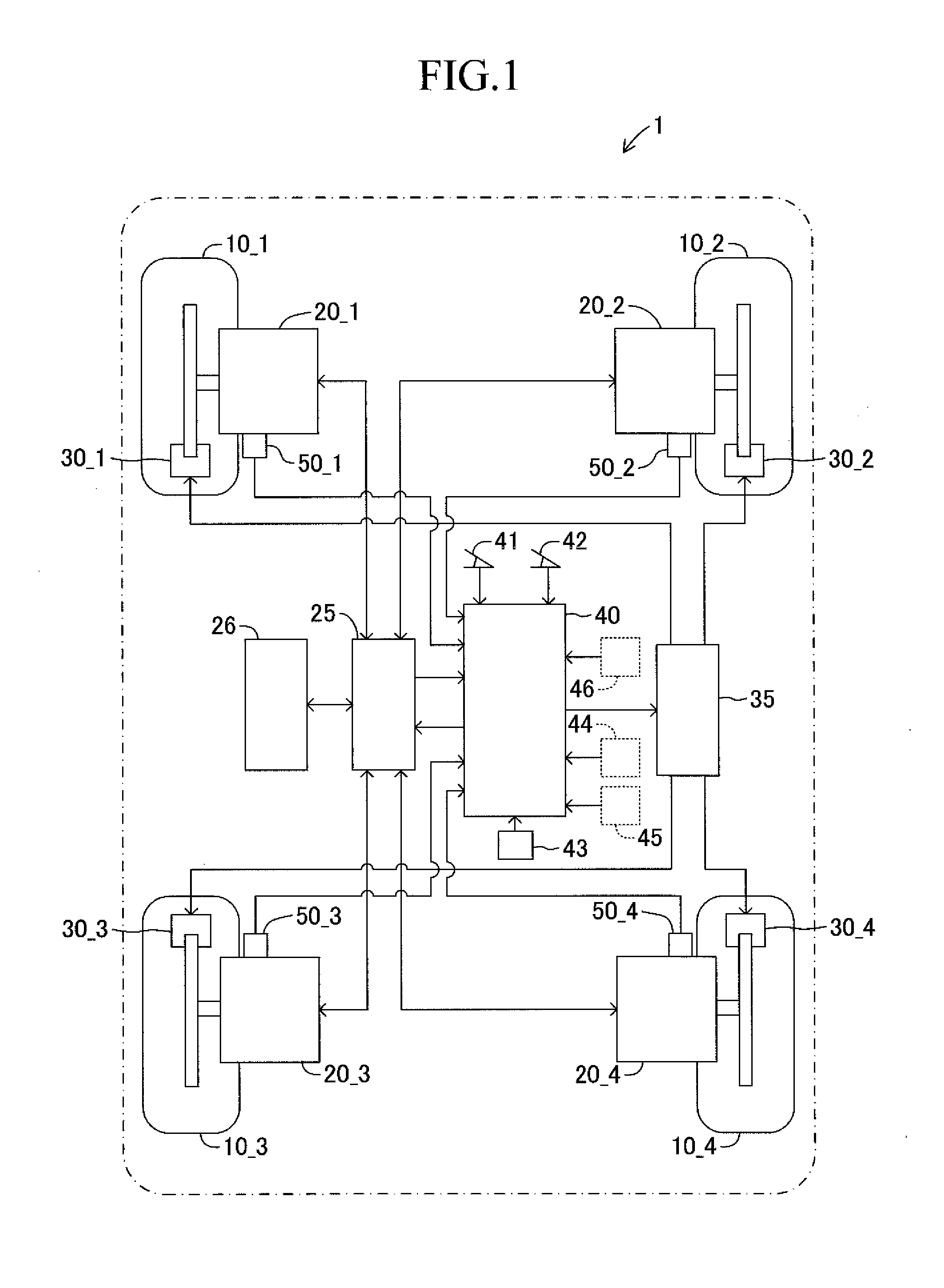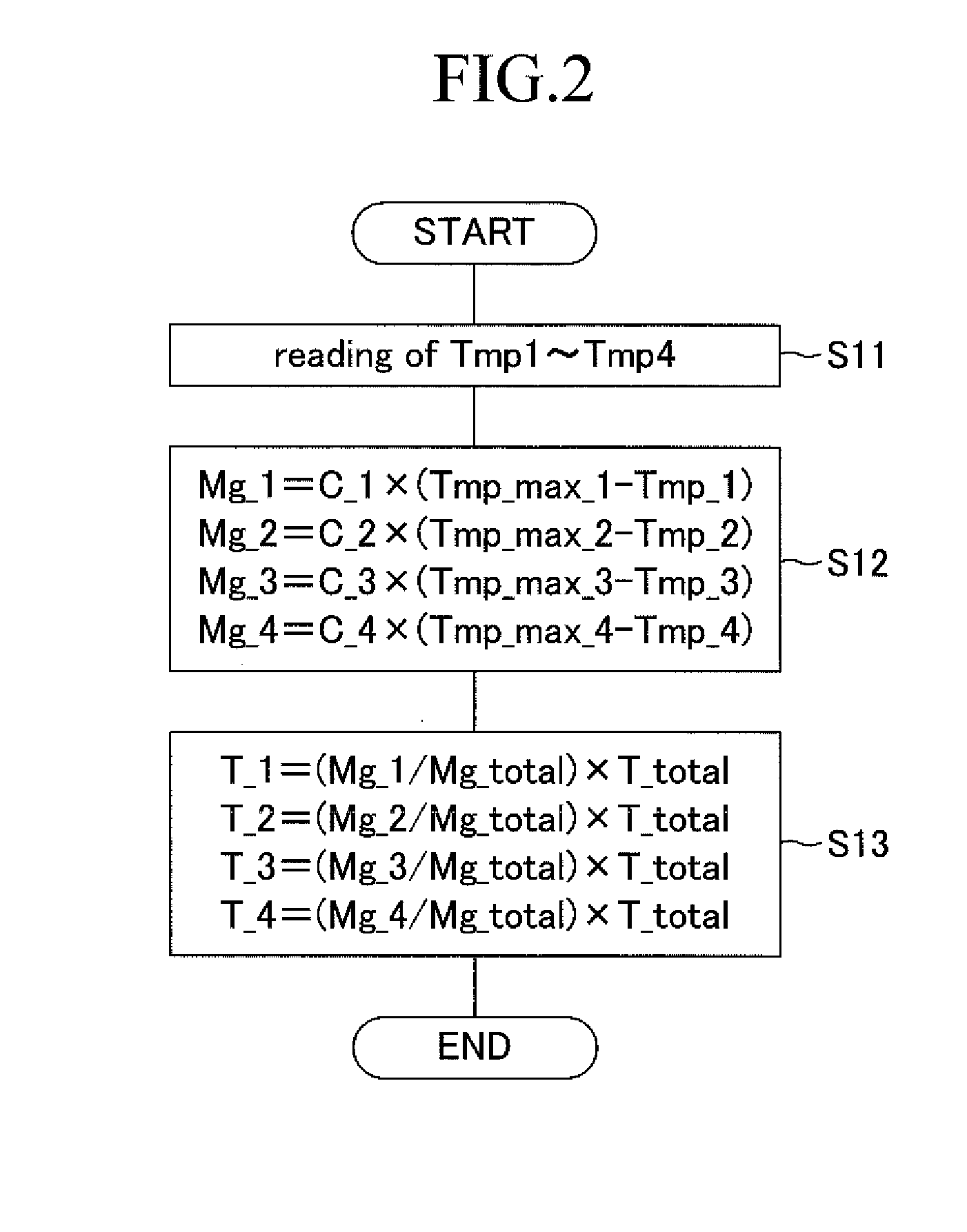Vehicle braking/driving force control device
a technology of braking/driving force and control device, which is applied in the direction of electric devices, brake systems, instruments, etc., can solve the problems of reducing the control property of yaw rate or lateral acceleration that can occur in the vehicle, reducing the braking/driving force of the motor, and reducing the control property of the yaw rate or lateral acceleration. the effect of good stability of the vehicl
- Summary
- Abstract
- Description
- Claims
- Application Information
AI Technical Summary
Benefits of technology
Problems solved by technology
Method used
Image
Examples
first embodiment
[0053]A method to divide the total requested braking / driving force into the requested braking / driving force for each wheel is described. FIG. 2 represents the braking / driving force distribution control routine performed by the ECU 40. The braking / driving force distribution control routine is performed repeatedly in a scheduled short period in the period when an ignition switch is turned on. Note that, about the braking / driving force distribution control routine, an embodiment here is referred to as a first embodiment because of describing a plurality of embodiments as follows.
[0054]When the braking / driving force distribution control routine of the first embodiment starts, in step S11, the ECU 40 reads motor temperatures Tmp_1, Tmp_2, Tmp_3, Tmp_4 detected by temperature sensors 50_1-50_4 provided with each in-wheel motor 20_1-20_4. Then subsequently, in step S12, thermal margins Mg_1, Mg_2, Mg_3, Mg_4 in-wheel motors 20_1-20_4 are calculated. In this embodiment, thermal margins Mg_1...
second embodiment
[0067]At high-speed traveling of the vehicle 1, the cooling performance of in-wheel motors 20 caused by the wind improves, but in-wheel motors 20_3, 20_4 of rear wheels 10_3, 10_4 are inferior to in-wheel motors 20_1, 20_2 of front wheels 10_1, 10_2 in cooling performance because of being hard to come in contact with the wind. Thus, in the second embodiment, the distribution of requested torque for each wheel is set to mainly use in-wheel motors 20_1, 20_2 of front wheels 10_1, 10_2 being easy to cool down at high-speed traveling of the vehicle 1, and the overheat of in-wheel motors 20_3, 20_4 of wheels 10_3, 10_4 is prevented.
[0068]FIG. 4 represents a braking / driving force distribution control routine performed by the ECU 40 as the second embodiment. In this the braking / driving force distribution control routine, the processing of step S12 of the first embodiment have been changed to steps S21, S22, S23, and other processing (S11, S13) is the same in the case of the first embodimen...
third embodiment
[0080]In the third embodiment, the vehicle 1 is provided with an acceleration sensor 45 to detect the load movement of the vehicle 1 in FIG. 1 as shown in broken line. The acceleration sensor 45 detects the acceleration G in the longitudinal direction of the vehicle 1 and outputs a sensor signal representing detected acceleration G in the ECU 40. The acceleration sensor 45 detects the acceleration in the longitudinal direction during acceleration and deceleration, and in addition, detects the acceleration in the longitudinal direction depending on the angle of the slope because a gravitational direction at the time of traveling on a downhill or an uphill relatively inclines to the longitudinal direction in comparison with at the time of horizontal traveling.
[0081]FIG. 6 represents a braking / driving force distribution control routine performed by the ECU 40 as the third embodiment. In this the braking / driving force distribution control routine, the processing of step S13 of the first...
PUM
 Login to View More
Login to View More Abstract
Description
Claims
Application Information
 Login to View More
Login to View More - R&D
- Intellectual Property
- Life Sciences
- Materials
- Tech Scout
- Unparalleled Data Quality
- Higher Quality Content
- 60% Fewer Hallucinations
Browse by: Latest US Patents, China's latest patents, Technical Efficacy Thesaurus, Application Domain, Technology Topic, Popular Technical Reports.
© 2025 PatSnap. All rights reserved.Legal|Privacy policy|Modern Slavery Act Transparency Statement|Sitemap|About US| Contact US: help@patsnap.com



